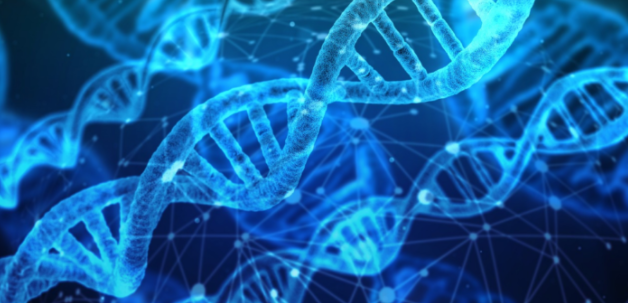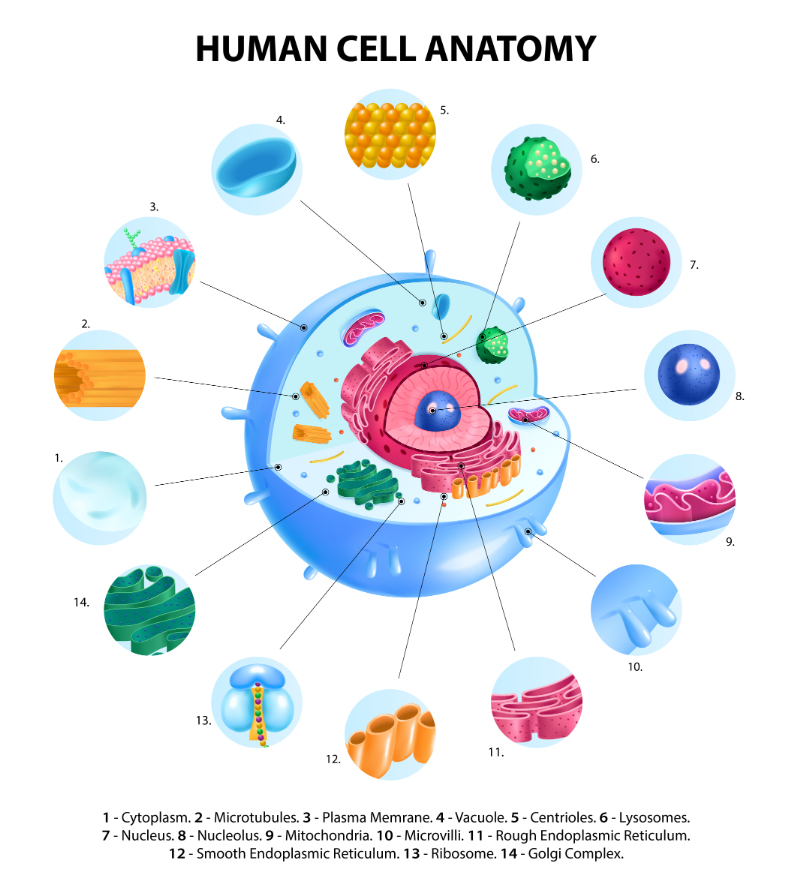Genomic Sequencing
Life begins and ends at the cellular level.
WHOLE GENOME SEQUENCING
Whole Genome Sequencing [WGS] is a technique that provides the complete genetic blueprint of an organism by analyzing its entire DNA – both coding and non-coding regions.
All organisms have a unique genetic code. It consists of a combination of DNA markers [Adenosine – A, Cytosine – C, Guanine – G, and Thymine – T] known as Single Nucleotide Polymorphisms [SNPs – pronounced “snips”].
WGS is the technology that identifies the unique sequence of the base pairs. WGS is the most comprehensive DNA test on the planet. Its impeccable accuracy assists in diagnosing several diseases and conditions that impact health, performance, and longevity within and between species.
WGS has numerous implementations:
→ Analyzing genes;
→ Detecting developmental delays;
→ Uncovering genetic mutations;
→ Solving complex medical problems;
→ Detecting outbreaks;
→ Investigating TB transmission;
→ Disease risk and diagnosis;
→ Early intervention;
→ Prenatal diagnosis;
→ Medical reactions:
→ Predispositions;
→ Rare disease detection;
→ Gene expression regulation;
→ Personalized medicine;
→ Immune function;
→ Multifactorial disease identification;
→ Medication responses;
→ Recessive disease identification;
→ And more
WGS is not merely applicable to human DNA. The DNA of different microorganisms, such as viruses and bacteria, can be sequenced to better understand the spread of infectious diseases, their origin, and prevention.
WGS represents the gold standard of genetic testing because it provides a base-by-base overview of DNA – [nDNA, mitochondria, and chloroplast].
Other testing types – exome, single-gene, SNPs – are limited to diagnosing single-gene or chromosomal structural variations in which variants could be missed.
Commercial tests typically implement DNA genotyping or autosomal DNA testing protocols. Neither of these approaches comes close to mapping one’s entire genome – including coding and non-coding regions.
Sequence analysis helps identify unknown genetic disorders and develop effective methods to prevent, diagnose, and treat these disorders in the future.

EPIGENETICS
Epigenetics explains gene expression through environmental stressors. Epigenetics represents the study of changes in an organism by modifying gene expression without altering the genetic code [DNA blueprint/sequence].
Epigenetics helps WGS depict cellular integrity. Knowledge of DNA sequences is indispensable to precision medicine, improved diagnosis, and prevention.
Epigenetics explains gene expression through environmental stressors. Epigenetics represents the study of changes in an organism by modifying gene expression without altering the genetic code [DNA blueprint/sequence].
“Epi” is the Greek lexicon for “above.” Epigenetic markers position above your DNA sequence and impact gene expression/suppression based on lifestyle factors [methylation].
Epigenetic testing provides incisive, data-driven, evidence-based measures and strategic actions to optimize health, performance, and longevity.
Methylation and acetylation represent critical processes in the body related to epigenetics. Methylation suppresses gene expression; acetylation activates gene expression. When methylation is out of balance, it causes systemic effects that can lead to undesirable outcomes.
Acetylation is crucial to desirable outcomes. Acetylation plays a significant role in detoxification. It works to help detoxify histamines, tobacco smoke, exhaust fumes, nutrition toxicity, supplementation overload, sleep deprivation, and medication, for example. Proper acetylation contributes to optimal organ functions and shields long-term imbalances.

Proper gene expression is a big deal. The mayhem begins when gene expression results in suppression – and vice versa – and its impact reaches far beyond a sub-par outing on the trails. It invites inflammation, chronic and degenerative diseases, accelerated biological aging, senescence, and numerous other undesirable outcomes – no matter one’s fitness level.
Epigenetics in the nervous system is the study of the interaction between epigenetic processes that regulate gene expression without altering your DNA sequence and the development, physiology, and function of your nervous system.
If those epigenetic mechanisms are disturbed, this can lead to a dysregulation in the balance between the sympathetic [SNS] and parasympathetic [PNS] nervous systems.
This dysregulation is called dysautonomia and is linked to the insidious induction of undesirable outcomes such as chronic pain, cognitive decline, diminished proprioception, inflammation, microbiome issues, hormonal imbalances, glutathione system disruption, chaotic mitochondrial biogenesis, and so forth.
Your DNA blueprint is absolute. Think of epigenetic markers as apostrophes sprinkled above the words and letters of a sentence [your DNA sequence]. Your DNA provides instructions for proteins produced inside the cells. Epigenetic markers impact [like a dimmer switch] how genes read cells.
Epigenetic testing represents all inputs from life – and what is possible. It identifies propensities that can be modified based on more than 1,000,000 variants. Find below some categories beneficial to snowshoers:
→ Sleep,
→ Stress;
→ Nutrition;
→ Supplementation;
→ Athletic performance;
→ Environmental health;
→ Hormones;
→ Biological age;
→ Neurotransmitters;
→ Endocannabinoid and glutathione systems;
→ Nitric oxide production;
→ Mitochondrial biogenesis;
→ Neuroepigenetics;
→ Heart rate variability;
→ Cognition;
→ Several more categories
Your DNA blueprint cannot be altered. Epigenetics represents what is possible. It represents propensities versus absolutes. Think of epigenetic markers as apostrophes sprinkled above the letters and words of a sentence or paragraph [your DNA sequence]. Epigenetics represents all inputs from life.
The beauty is propensities can be modified – from sleep, stress, cognition, performance, recovery, endurance, nutrition [nutrigenetics and nutrigenomics], supplementation, hormones, microbiome, neurotransmitters, glutathione system, nitric oxide production, plant sterols, insulin resistance, mitochondrial biogenesis, and numerous other categories.
DNA provides instructions for various functional proteins to be produced inside the cell. Epigenetics impacts how genes are read by cells and, subsequently, whether the cells should produce relevant proteins.
The promise of epigenetics is its depiction of cellular integrity. When variants highlight abnormal cellular function, it allows the opportunity to reverse chronic, degenerative, and autoimmune states and enhance health, performance, and longevity via modification of gene expression through lifestyle changes.
Precision genomic interpretation, performance nutrition, supplementation, neuro mapping diagnostics, neurofeedback, epigenetics age assessment, comprehensive diagnostics, heart rate variability, biometric monitoring, neuroepigenetics, and the like complement modifications to gene expression.
SNPs represent the keys to this cutting-edge paradigm of optimizing gene expression. In an ideal world, the A allele pairs with the T allele, and the C allele pairs with the G allele. Life is not ideal and offers a different set of parameters – many unpredictable. Therein lies the benefit of matching desired outcomes with propensities.
The invaluable art of applying complicated data to complex thinking is “augmented intelligence.” The precise interpretation of the data is the key to transcending health, performance, and longevity in life and sport. Epigenetics is invaluable to the impeccable accuracy of WGS.
“Epigenetics Revolution” by Nessa Carey provided the following epigenetics analogy.
Think of your life as a movie:
– Cells represent the actors – the essential units that make up the movie;
– DNA represents the script – instructions for all participants of the movie and their roles;
– DNA sequence represents the words on the script;
– Genes instruct key actions or events to occur;
– Genetics represents screenwriting;
– Epigenetics represents directing all elements of the movie. The director can alter the film by tweaking scenes, dialogue, and so forth. Steven Spielberg would create a different product from Woody Allen – even though both had the same script.
WGS implements specific techniques such as Whole Genome Bisulfite Sequencing [WGBS] to analyze epigenetic modifications across the entire genome – which makes it an invaluable tool for epigenetic research. WGBS is a specialized form of WGS that allows the detection of DNA methylation patterns.
MITOCHONDRIA | ENDURANCE PERFORMANCE
WGS is an invaluable tool for understanding the role of genetic variants in sports performance. Mitochondria represent one of the most important organelles within a cell.
Mitochondria represent the “powerhouses of the cell.” The process these organelles implement to convert glucose, amino acids, and fatty acids from macronutrients – carbohydrates, proteins, and fats – into molecules termed ATP [adenosine triphosphate] is mitochondrial biogenesis. ATP is the energy current of the cell.
Mitochondria are crucial to WGS because they possess distinct DNA [mtDNA], which can be sequenced parallel to the genome to enhance the breadth of complex data.
WGS can help athletes improve their performance by identifying genetic variants that affect physical performance, health, and psychological traits. WGS can also help reduce the risk of injury and improve recovery time.
WGS has great potential to explore all possible DNA variants associated with physical performance, psychological traits, and health conditions of athletes. Find below a few key areas:
→ Exercise and mitochondrial adaptations;
→ Mitochondrial DNS and athletic performance;
→ Mitochondrial ADP sensitivity;
→ Antioxidant supplements;
→ DNS variants;
→ Genetic markers;
→ Injury diagnosis and prevention;
→ Injury recovery;
→ Talent identification;
→ Personalized nutrition;
→ Personalized training programs;
→ Energy production;
→ Disease diagnosis;
→ Maternal lineage tracing;
→ Population genetics;
→ Forensic applications;
→ Research;
→ Mitochondrial genome reconstruction;
→ DNA variants;
→ Genetic markers
Mitochondrial Function
Mitochondria represent one of the most important organelles within a cell.
It is found in significant numbers in which the biomechanical processes of respiration and energy production [ATP synthesis] occur. Its importance to sports performance is unequivocal.
This energy-producing cellular powerhouse portion of your cells is responsible for 97 percent of your body’s chemical energy by capturing energy generated by food breakdown during organic compounds’ oxidation.
There are at least 400 mitochondria per cell and thousands per cell respective to heavy hitters like your brain, liver, and muscle tissue.
Mitochondria crave proliferation to meet the increased energy demands of endurance athletes.
A balance of duration and intensity in your training/exercise regimen combined with interval training not only improves your fitness level and endurance sports performance but supports the greatest adaptive mitochondrial response.

Mitochondria structure is uniquely comprised of strands from both your parents [nuclear DNA | nDNA] and a strand solely from your mother [mitochondrial DNA | mtDNA]. The mtDNA strand is particularly useful in genealogical study.
The myriad and breadth of differences between nDNA and mtDNA in terms of structure, composition, inheritance, recombination, mutation rates, number of copies, and other characteristics is beyond the scope of this article.
Mitochondrial membranes and mtDNA are highly susceptible to oxidative damage from free radicals. The damage frequency to mtDNA is nearly 20 times more than nDNA.
This is important because the lack of protective molecules [histones] combined with the damage rate leads to an mtDNA mutation rate 17 times higher than DNA.
This progressive mutation rate stifles mitochondrial energy production and plays a critical role in the accelerated aging process theory.
Oxidative stress is the burden placed on organisms by the constant production of free radicals in the normal course of metabolism.
This burden causes toxic effects through the production of peroxides and free radicals, resulting in cellular damage to proteins, lipids, and signaling pathways.
Said interplay results in energy depletion, cellular instability, inflammation, tissue dysfunction, accelerated aging, chronic and degenerative diseases, and the proliferation of free radicals versus antioxidant capacity.
One of the fiercest generators of free radicals is the burning of food in the mitochondria. Free radicals are metabolic waste products that turn food into energy.
Toxins, infections, allergens, and nutrient-deficient foods create metabolic waste. The bottom line is that free radicals severely impair the ability of the cells to produce energy in the mitochondria. The ultimate loss of energy is death.
Our body has a built-in mitochondrial protection system but is overwhelmed by the workload. Issues arise when we are out of balance. The system is termed REDOX because of the REDuction [reduction] and OXidation [oxidation] chemical processes. REDOX concerns chemical reactions in which oxidative states have been altered.
REDOX represents a family of reactions concerned with the transfer of electrons between species. Reduction is a decrease in oxidation through the gain of electrons. In contrast, oxidation is an increase in oxidation via the loss of electrons – a reversible chemical reaction in which one reaction is an oxidation, and the reverse is a reduction. This ongoing cellular feud impacts mitochondrial health.
Consuming too many calories and not enough micronutrients breeds illness. The typical diet contains too many calories and anti-nutrients, and it is complete with an antioxidant shortfall. A balanced REDOX system and mitochondria protection are the keys to optimal health, improved endurance sports performance, and graceful aging.
Anti-nutrients remain staples in the typical North American diet. These include animal foods/protein, saturated fat, hydrogenated/trans fatty acids, cholesterol, oil, sodium, artificial sweeteners, sugar, artificial colors, monosodium glutamate/MSG, high fructose corn syrup, and hydrolyzed vegetable protein.
Find below some of the several diseases linked to mitochondrial damage.
→ Alzheimer’s disease;
→ Huntington’s disease;
→ Parkinson’s disease;
→ Autism;
→ Epilepsy;
→ Cardiovascular and related diseases;
→ Chronic fatigue;
→ Fibromyalgia;
→ Diabetes;
→ Migraine headaches;
→ Other neurodegenerative diseases;
→ And more.

Efficient mitochondrial function is vital to endurance athletes.
Increased mitochondrial size and density will bless an endurance athlete with enhanced respiratory, cardiovascular, and musculoskeletal proficiency. Increased mitochondria and myoglobin enhance the art of energy production and the capacity for oxygen storage within the muscle.
Myoglobin is a protein that binds with oxygen in the muscle fiber. Myoglobin releases the oxygen to the mitochondria when oxygen becomes depleted during exertion.
It is unclear the degree to which myoglobin content contributes to the oxidative capacity of a muscle, but evidence suggests that endurance training increases myoglobin content, which increases the oxygen reserve in the muscle.
Some of the benefits to endurance athletes include:
→ Improved blood flow and oxygenation;
→ Reduced fatigue;
→ Increased energy production [ATP];
→ Enhanced muscle fiber interaction [elasticity | efficient contractions]:
→ Improved heart function [stroke volume | cardiac output];
→ Improved circulatory system efficiency;
→ Health at the cellular level.
Protect your mitochondria and prevent rusting like a vehicle or a bowl of apple slices on the counter. One of the keys to optimal health and endurance sports performance is regeneration. Snowshoeing, trail running, and other forms of exercise provide reasons for your body to regenerate.
Regeneration is an ongoing process that transpires at the cellular level. The rate at which your body regenerates is dependent on the quality of dietary fuel to support it.
Poor nutritive decisions convert the complementary stress produced by exertion into uncomplimentary stress. A nutrient-deficient diet combined with strenuous exercise will hasten cellular degeneration and advance the aging process.
Regular consumption of primary source, alkaline-forming, easily digested, absorbed, and assimilated nutrient-dense whole foods supports cellular regeneration and optimal mitochondrial function, which translates into more energy production for your endurance outings in addition to heightened wellness.
Growth has no endpoint…
Merge knowledge of your genetic code, blood analysis, biological age, and heart rate variability with curated consults tailored to your needs. We have the technology to eliminate guesswork, decode superhumans, and propel limitless potential.
Challenge yourself today to boldly manifest the keys to your mansion of unparalleled health, performance, and longevity from the inside out.
A limitless life is a choice…
Find more information at Performance Medicine™.
Schedule a FREE CONSULTATION via the blue widget, our contact form, or 401.207.4215.



